- Proton beam to NA all day on Wednesday 27th (no MD)
- The proton beam will stop on Thursday 28th Septmber at 8:00. This is followed by DSO tests planned from ~08:30 and setting up of the operational SFTION cycle with extraction & target steering.

check out the EATM meeting last Tuesday!
indico.cern.ch/event/1329739/
The agenda for this meeting is based upon user schedule 2.0.0, please cf. here. Please note the current injector schedule which contains information about MDs, Technical stops, etc. and can be found here.
New user schedule including all the agreed changes to be published asap!
Next user meeting:
For week 40 on Thursday, October 5th, 2023 10:30 CEST
Meeting room: 874/1-011 (CERN)
Check the Page 1 on the machine vistars for most up-to-date information of the beam availability:
https://op-webtools.web.cern.ch/vistar/vistars.php?usr=SPS1
https://op-webtools.web.cern.ch/vistar/vistars.php?usr=CPS
Now, during the LHC ion commissioning period more last-minute changes can happen than usually during the run.
During the rest of the run: Dedicated LHC filling with ions trains in the SPS. The fillings might last around 1 hour and repeat about every 5 hours.
For an invesitation into the 50 and 100 Hz on the NA spills, the automatic feed-back system needs to be switched off for a couple of spills. This might happen in the morning and the afternnon of September 21., 22, 25 and 26 - it should last only for 4 to 6 spills each time.
Injector Schedule
An updated version of the injector schedule for 2023 has been presented at the IEFC Friday September 1st:

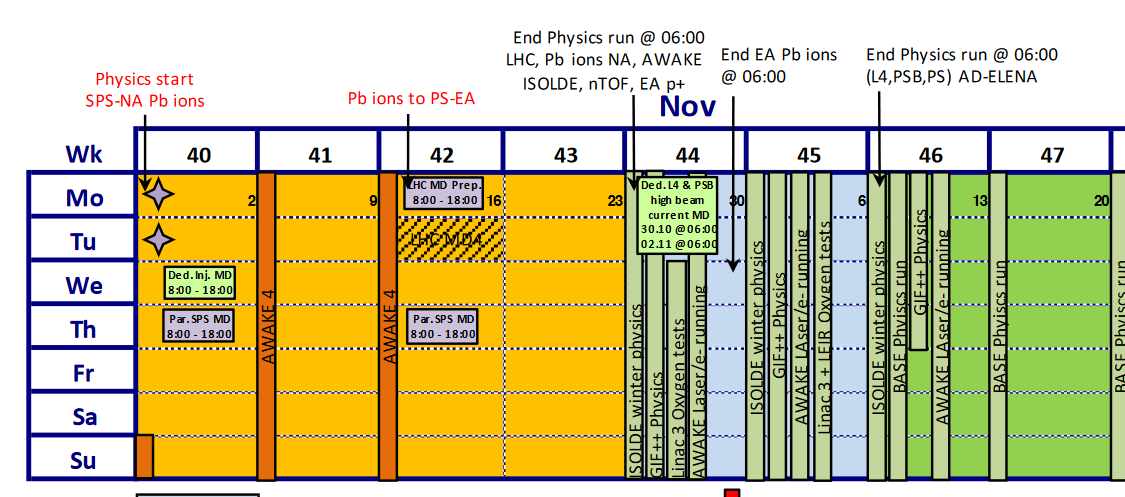
Other
How to best schedule the MDs?
Machine availability: good, however, with important perturbations for NA physics given LHC ion setting up & frequent, long fills. Thanks for your understanding.
Tuesday - Thursday: suddenly strong 50 Hz spill noise, difficult to keep under control. To be investigated.
Today
Friday: beam stop at 13:30, followed by radiation survey (14:00 - ~16:00).
Next
Apologies from the EP Safety Office for the problems experienced by all using our website. The problems have now been resolved and the website and ISIEC site is fully functional again - if anyone experiences any further problems, please send an email to the EP Safety Office with your requested inspection time.
No specific safety points this week - thank you to everyone for ensuring safe practices whilst at CERN.
General: In all experimental areas the physics programme is running nicely without major issues.
EAR1: In EAR1 the transmission measurement tests are on-going. For this week we are using the filter station to perform different transmission measurements. Preliminary results are very promising.
EAR2: The 26Al(n,p/a) is running nicely. This is the last week with this detector and will be devoted to auxiliary measurements with LiF and boron samples. Next week the same reaction will be studied by recording charge particle reaction products at forward angles using the Si position sensitive nTD annular detector.
NEAR: No inteventions this week but a number of interventions are exected the coming week. PS will be informed as soon a specific planning is available.
Special beam requests: Between 3/10 -17/10 cycles with low intensity 10E10 ppp will be needed. As soon specific planning becomes available this will be communicated directly with PS-teams.
PoT: 1.95E19
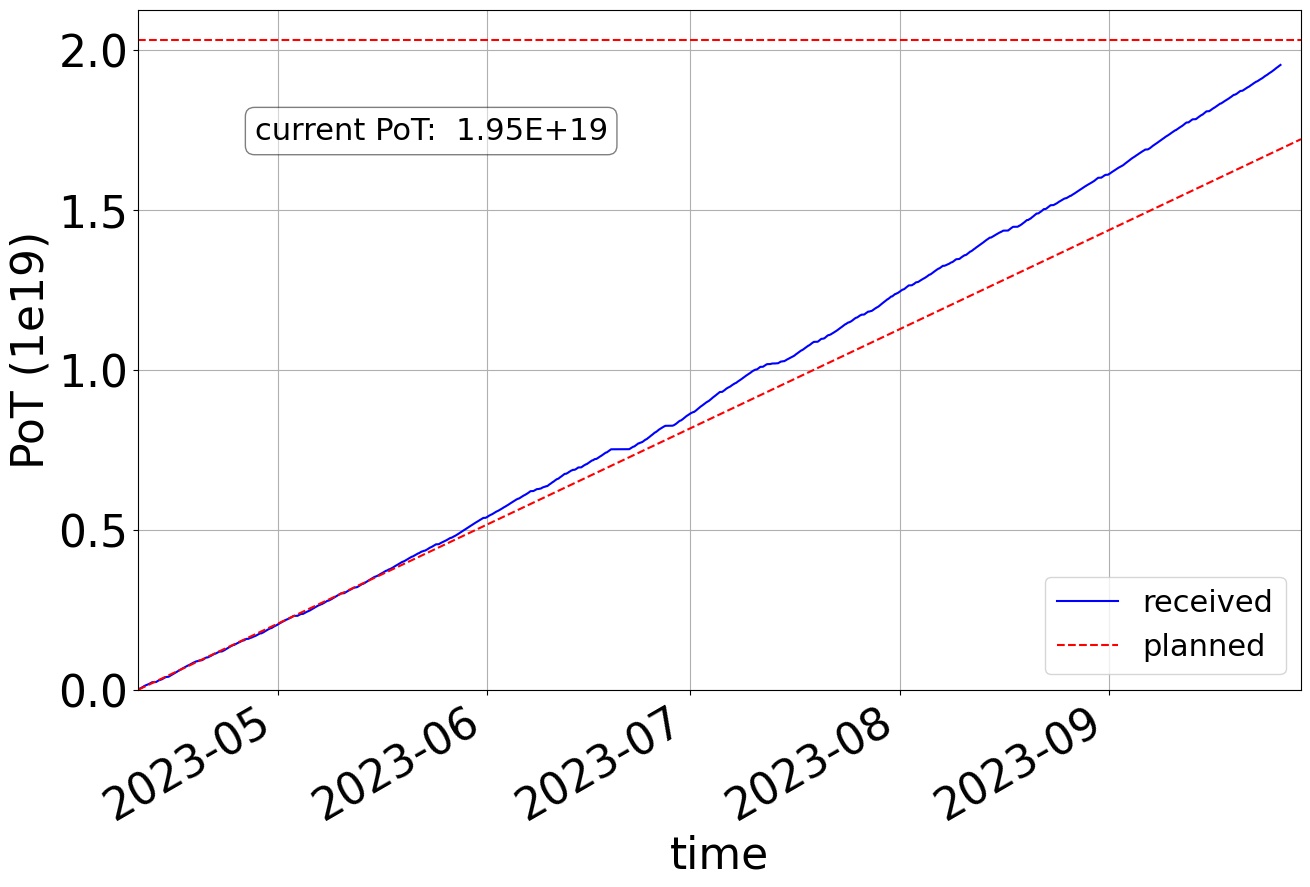
Expected beam stops at n_TOF
East area overall:
T09: Issues with CESAR and profile monitors. This is being followed with the experts. Otherwise good operation.
T10: Good operation.
T11: Beamline running and checked beam profiles with CLOUD.
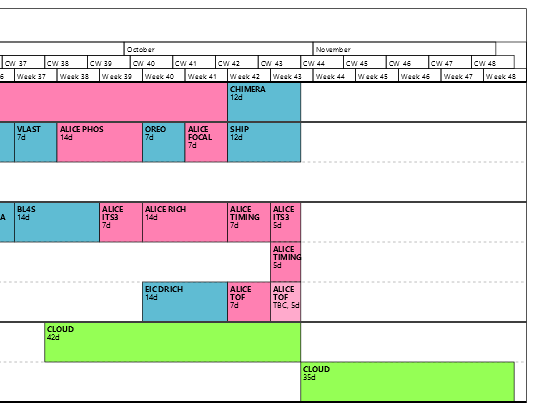
Good week, no issue with operation. Weekly intensity level close to the target value (~1.9e16 p/w, see plot below) Beam alignment and center on both X- and Y-axis was very good (e.g. number of spills centered within +/- 2mm): ~>96%.
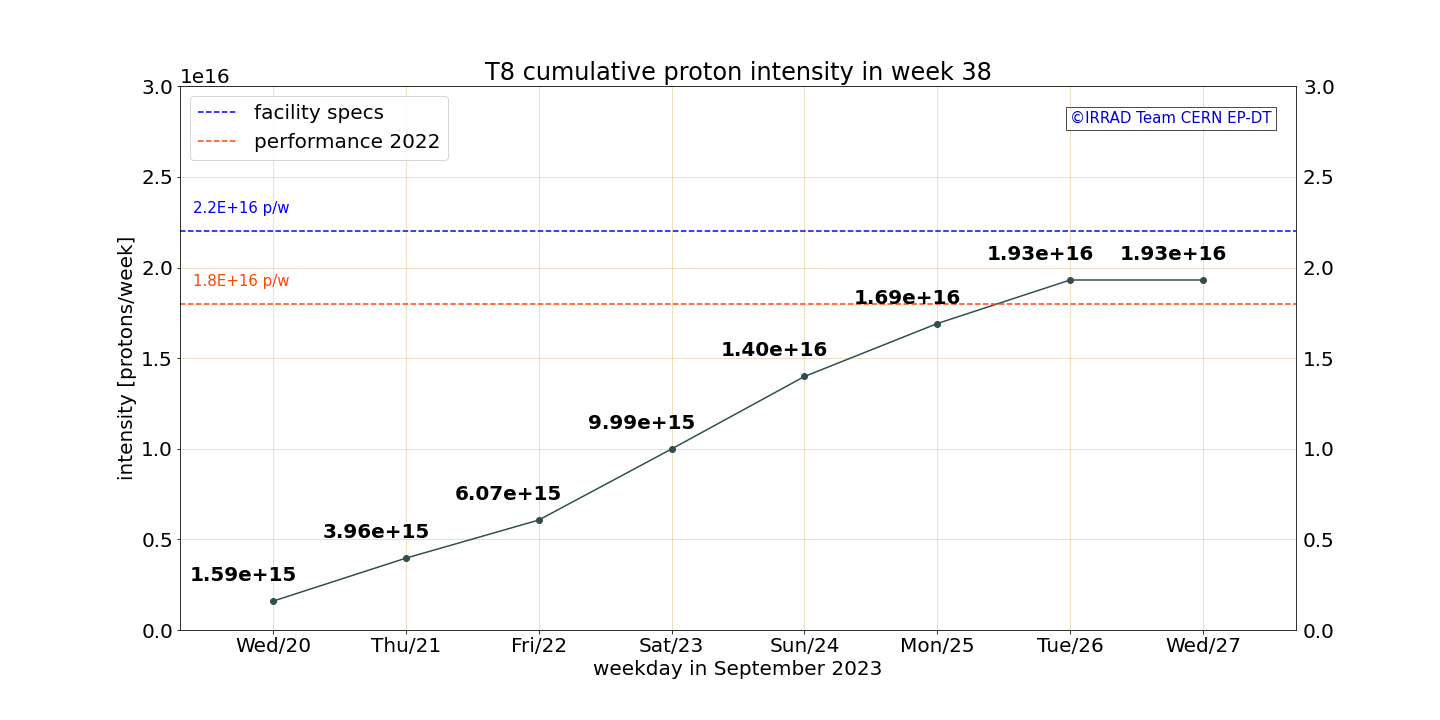
During the access on Wednesday, in IRRAD we exchanged the dosimetry and installed new experiments for LHCb (optical fibers, calorimerty cristal samples for very short irradiations during the week). The cryostat and long-term experiments in Zone 3 continue. In CHARM we installed a new setup from TE-MPE while BE-CEM continues testing. After the access and the resart of the beam operation we experience now problems with the IRRAD-BPM devices now under investigation (missing data in OPWT).
With new FEC_32 readout card were measured:
-energy resolution in energy range 0.5-5 GeV for 2 calorimeters first with Hamamatsu 10x10 mm area APD and second with small area Hamamatsu 3x3 mm MPPC
-time resolution, we have got ~200 ps@ 1 GeV deposited energy in crystal.
FEC_32 perfectly works and complies ALICE/PHOS requirements.
Plans:
continue data taking with calorimeter equipped with large area MPPC in 0.5-5 GeV
Go to high energy 10 GeV, 7 GeV
Some problems with CEDAR (two times-26.09 and 27.09) - can’t load beam file. Computer reboot dosn’t help.
Beamtime: 4 October 2023 - 11 October 2023
Goal: Test a prototype of ultra-compact electromagnetic calorimeter based on oriented crystals
Beam request: Low-divergence wide-profile tertiary electron beam at 6 GeV (The beam used for STORM and Techno-CLS are fine)
What is needed in the area
No magnets are needed!
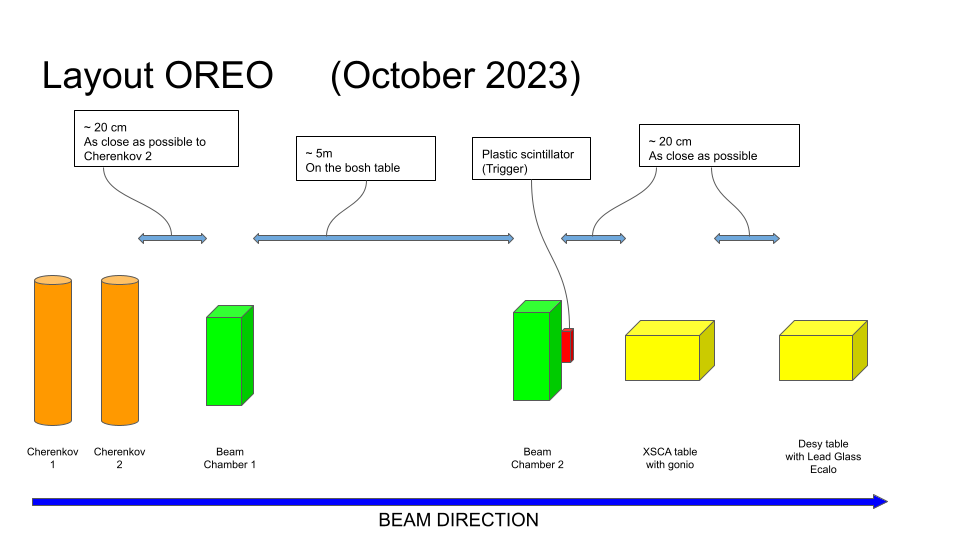
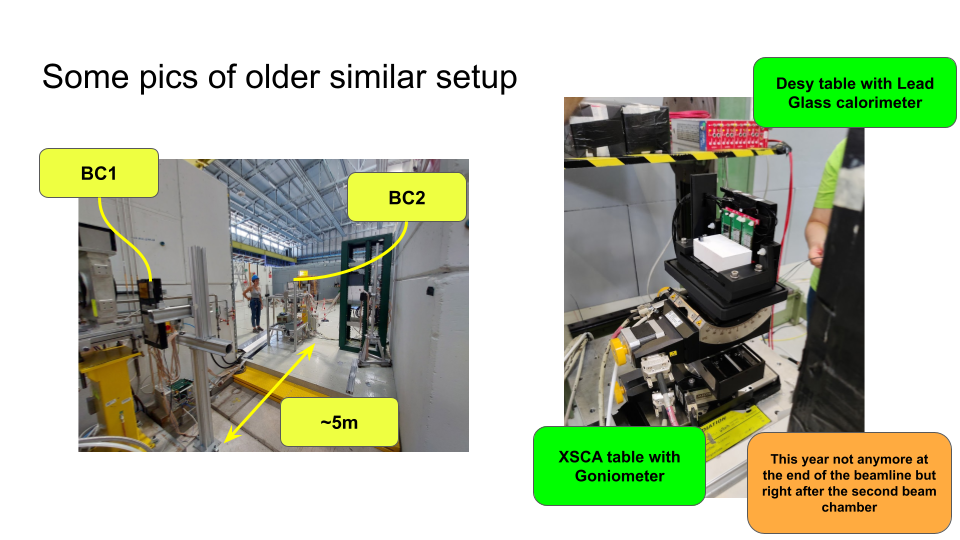
We have safely moved out and already progressed with our data analysis. The XCET043 seems to not operate well with He and also just much more noisy compared to the high pressure one, and also not as efficient at low pressures.
We(BL4S team and all the stufents) are very thankful for Maarten van Dijk, Jocelyn Tan, Dragoslav Lazic and Eva Barbara Holzer for all the help they have provided.
Istalled as planned
safety clearance at 15:00, taking data since then
perfect beam
Beam time 4-18 Oct, 2023
Goal: R&D for ALICE3 experiment studies for a RICH prototype equipped
with aerogel radiator and SiPM photosensors. Characterization of SiPM sensors and related readout electronics in particular with respect to response to single photon-electron and timing properties.
Set-up: The prototype consists of a Al cylinder with aerogel and SiPM arrays;
upstream/downstream plastic scintillator fingers for external triggering purpose and 2 X-Y fiber tracker module (upstream/downstream) for beam monitor position and tracking.
ISIEC submitted (ID 1087); safety inspection booked at 4PM on Oct 4, 2023.
Beam time from October 4 to October 18.
Goal: test a dual-radiator RICH prototype with an extended SiPM readout plane.
The dRICH prototype has been tested in August on the same beam line with a reference detector based on multi-anode PMTs and MAROC readout chip. Due to the strong magnetic field expected at EIC, novel sensor types should be validated for Cherenkov application. The new readout unit comprises arrays of SiPM covering a 5x5 cm2 area, and ALCOR readout chips.
CLOUD setup is largely finished - started data taking on Tuesday. Everything is going well so far. We are already taking very interesting data of a chemical system that seems to be very sensitive to ion concentrations.
Week mainly dedicated to electron beam commissioning:
Other activities: CV in TCV4 for pipe measurements, GSM connectors in TSG41/TSG4, cleaning of TAG41 and control room
Next steps: 2 weeks to go before proton run. Contractor visits for plasma source (this week) and laser (next week). Installing more cameras for plasma light.
Overall: Issue with CO2 gas delivery Sunday night, an automatic switch to the backup gas battery did not work. New stand-by service in place, but TI control room did not know the phone number. Now again communicated and operation teams made aware.
H2: Normal operation.
H4: Normal operation.
H6: One fault in QUAD.041.434. Found to be caused by the repeated switches to the ion cycle in the SPS, but easily reset. Caused a bigger beam spot in H6 for one night.
H8: Single fault in QUAD.042.320, caused large beam for around two hours.
M2: Hadron beam tests by AMBER and MUonE for +100 GeV/c and -100 GeV/c on Wednesday. Alignment checks done for these beam. Good operation.
P42/K12: Very few magnet trips, but overall good operation. Some delays due to late patrols of TCC8 and galleries. Vacuum degradation test successfully done, useful to define now limits for vacuum operation in P42 with respect to radiation protection and beam instrumentation performance.
Smooth data taking until the end, with a few hiccups:
We are very grateful for all the help and support from the SPS experts and operators. Thank you very much!
Over the week we have put in operation all the available equipment.
Nevertheless, we consider to have concluded our measurements.
We would like to express again our gratitude to those that helped us both during the preparation, safety implementation and operation of the beam and spectrometer. Special thanks to Dipanwita who again made it possible to have a successful data taking.
Our spectrometer is now going to the winter mode, we should be in the safe mode (Hydrogen removed from the TPC) within today.
See You next year.
2 weeks of beam test
During the first 5 days we tested 4 different silicon modules with electron and muon beam. DAQ with single module teststand.
Then we switched to test of 2 module sinchronously with the full HGCAL electronic chain (1st time). We tested the modules with electron muon and pion beam.
Setup in PPE156 removed this morning. RP measurements performed.
This was a very successful testbeam run, despite the fact that the DUTs and the DAQ system were available only a few days before the start. We had to spend some time in commissioning the DAQ itself. Nevertheless we managed to collect enough data, with three devices (ETROC2 + LGADs) well aligned, to obtain detailed studies of the ETROC2 chip performance. DAC threshold scans performed (chip discriminator). Data taken in “low” and “high power” mode. Eudet tracker not integrated.
Very positive interaction with the many parallel users, thanks a lot to them. Moreover, thanks to the beam experts for their support and coordination effort!
We managed to carry on successfully the physics program of both Sci-Fi and RICH.
Currently, we are dismounting all set-ups in PPE 138 and PPE 168. Furthermore, we have scheduled the necessary visits from RP personnel and the crane operators for today.
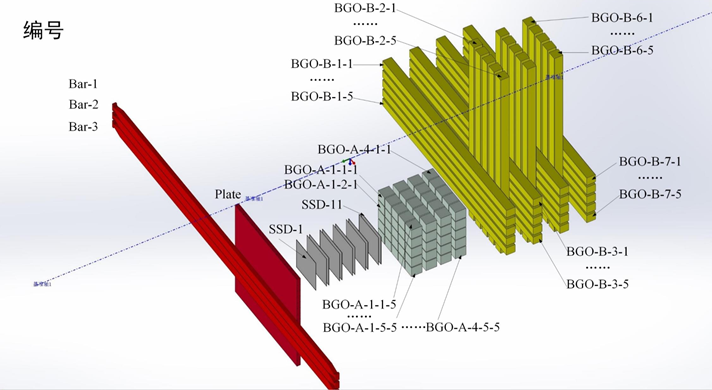
More night shifts were transfered by CMS team last week. HERD took about 180 runs and about 8 M triggers at SPS-H4 in the last two weeks. 300GeV protons, 150&250 GeV muons were taken for MIP calib. and cross-calibration. Electrons with 20~250 GeV were taken at different positions of the calorimeter and at different incident angles for 3-d reconstruction and PID preparing.
Preliminary data analysis shows that the IsCMOS cameras well reconstructed the particle energy. An energy resolution of 2.3%@200GeV was achieved w/o detailed cross-calibrations inside the camera.
Thanks to the CMS HGCAL team again for the sharing of SPS proton beam time! Otherwise the validation of optimized design of HERD calorimeter would not be possible.
Plan next week:
Keep the sub-detectors inside H4, and take ion beam as parasitic user in WEEK Oct. 2nd. To check PID performances by using Deuterium and to check Z performances by using A/Z=2.2 configuration.
Two detector packages were fully tested and they are left in the Roman pot staation for further tests in case of needs.
Many thanks for all the crew services of the NA for their fast actions when it was required.
Minutes by the respective speakers, edited by E. B. Holzer, M. Jaekel, and M. Schwinzerl